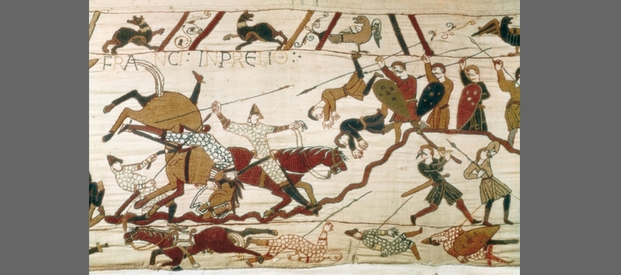Battle of Hastings 950th Anniversary
The Battle of Hastings, 1066 is one of the best remembered events of British history. And rightly so because it marked a turning point in the lives and fortunes of the people of medieval England, and had consequences which affect the whole of Britain to this day.
At this time in October 2016, we remember that decisive battle of exactly 950 years ago, and take a look at the lasting legacy of the Norman conquerors.
1066
1066 was a turbulent year. In January, Edward the Confessor died, leaving three men as contenders for the English throne: Harold, an English nobleman, Harald Hardrada, King of Norway, and William, Duke of Normandy. Harold had himself crowned straight away in Westminster Abbey, and immediately set his armies along the south coast ready to defend the country against attack.
Meanwhile William, Duke of Normandy made plans for an invasion of England. He gathered the support of the barons of Normandy and Brittany, promising land and positions in his new kingdom. He assembled his fleet and his men on the French coast and waited for the right moment to attack.
In September, Harald Hardrada’s Norwegian army invaded the north, defeating the Northumbrian forces at Fulford outside York. Harold’s army raced north to make a surprise attack on the Norwegian invaders and defeated them in the Battle of Stamford Bridge. But while Harold was busy in the north, William of Normandy seized his opportunity and invaded from the south.
The Battle of Hastings
With reduced numbers and exhausted men, Harold marched south. William of Normandy had a large army, but Harold’s soldiers took up a strong position at the top of a hill and formed an impenetrable wall of shields, holding off the Normans for most of the day. This stalemate continued until part of William’s army pretended to run away. When some of Harold’s soldiers gave chase, William’s men turned around and slaughtered them, then broke through the weakened front line, killing Harold and many of his men. The Normans won the battle and William the Conqueror became king of England.
How the Normans shaped our future
After the Norman Conquest, French nobles replaced Anglo-Saxons in all positions of power and authority throughout England. Never before or since, has there been such a quick and complete change to the ruling class. With the Normans, came lasting changes to the language and landscape of the country.
French and Latin became the languages spoken in government, society and the church, while old-English was spoken only by the poor and uneducated. Children were given French names such as William, Robert and Henry, and Anglo-Saxon names fell out of use. Even today, although our language still retains some Anglo-Saxon influence it includes many French and Latin words too.
In Britain’s landscape before the Norman Conquest, there were no castles at all. But William the Conqueror had to work hard to keep down Anglo-Saxon rebellions and he built many defenses; first motte and bailey castles, and then huge stone castles which were fortresses as well as homes for the new French nobles. Many of these, such as Leeds Castle and Chepstow Castle and others at Carlisle, Dover and Kenilworth, are still part of our landscape today.
Marking the day
This year on the 950th anniversary of the famous battle, more than 1,066 Norman and Saxon soldiers dressed in chain mail, with spears, shields and colourful banners, gathered on the original battle site to commemorate this important day with a re-creation of the Battle of Hastings.










